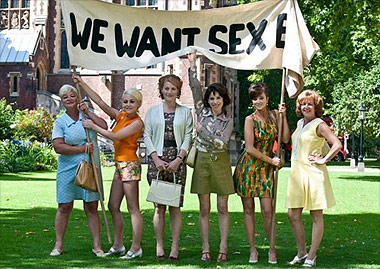
| HOME |
| NERVE |
| REVIEWS |
| ARCHIVE |
| EVENTS |
| LINKS |
| ABOUT US |
| CONTRIBUTORS |
| BACK ISSUES |
| CONTACT US |
 Made
in Dagenham (15)
Made
in Dagenham (15)
Directed by Nigel Cole
Written by Billy Ivory
On general release from 1st October 2010
Reviewed by James Whitelock
Made in Dagenham is a dramatization of women workers at Ford’s Dagenham factory campaigning for equal pay to their male colleagues.
I went to see Made in Dagenham unsure of what to expect. I didn’t know much about either the car strikes or the Equal Pay Act that followed in 1970. I ended up enjoying the film immensely.
The use of buildings and fashion along with other cultural references clearly signifies that this is the 1960s. It is also a film that places women at the very centre. However, women’s and men’s spaces are clearly coded. The factory floor belongs to the women; the boardroom to the men. I have never been to Dagenham, and like many people whilst visiting London have only seen wealthier areas closer to the centre. This film however is very much working class London. A search on the internet revealed that although once part of Essex, Dagenham is now part of the London Borough of Barking and Dagenham.
What starts out as a protest over the women wishing to be classified as semi-skilled workers ends with a campaign for equal pay. The women were also supported by their fellow workers in Halewood, though this is only briefly shown. Many male workers are also supportive.
Perhaps the most moving point of the film for me was the meeting between the leader of the strike and the wife of one of the directors at Dagenham. This takes place just outside the home of one of the women on a post war Dagenham estate. The director’s wife, Lisa Hopkins, tells us that although she has a first class degree in History from Cambridge, her husband treats her like a fool. This moment and all that it implied including crushed dreams and hopes I found highly moving. Rosamund Pike who plays Lisa Hopkins was very good. I found all the performances convincing.
Miranda Richardson is excellent as Barbara Castle, who takes on the might of Ford. Bob Hoskins as perhaps the only central male role was also excellent. The relationship between the leader of the women and her husband is well explored. Geraldine James, as always, is outstanding. However the central role is clearly Sally Hawkins as Rita O’Grady who takes on the male hierarchy in the unions, Ford and also Westminster.
One of the problems of the film is trying to convey the sense of such a lengthy process within the confines of a film. Inevitably, some elements are left out. The intertwining lives of the two women, Lisa Hopkins (this seems to be the only status she has, i.e. defined by her relationship to another) and the other, Rita O’Grady, could have been further explored.
Ultimately the film reminds me of how far Labour has diverged from its original founding principles. Would an Employment Minister meet with strike leaders today? Perhaps. However, the film does help me to imagine (I am only thirty-four) a time when Labour ministers and leaders did not try so desperately to distance themselves from the trade union movement and the wider ideology of the left. Ed Miliband, take note.
However, the film also reinvigorated my hope in the capacity of politics to make things better for ordinary citizens. Footage at the end credits of some of the actual women and their stories highlighted that this was ultimately their film.